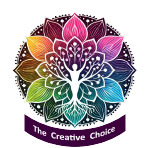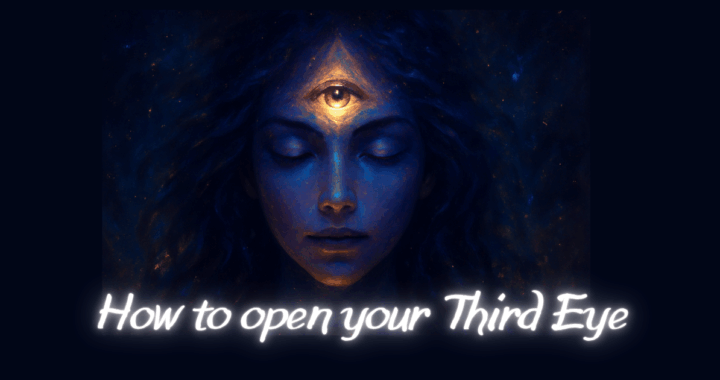The third eye is one of the most ancient and widely recognised spiritual symbols, often seen as a gateway to deeper perception, intuition, and inner wisdom. Associated with the pineal gland and the Ajna chakra in yogic tradition, it plays a key role in practices focused on awakening consciousness. Many spiritual seekers explore how to open your third eye as a way to deepen meditation, enhance inner vision, and connect with their higher self.
What is the third eye – and how do you open it?
In Hinduism, the third eye is linked with the Ajna chakra, the sixth energy centre, believed to govern insight and foresight. It is often depicted as a visible eye on the forehead of deities like Shiva. In Buddhism, the “eye of wisdom” symbolises spiritual awakening. The Ancient Egyptians associated it with the Eye of Horus — a symbol of protection and higher perception. Even Christian mystics have spoken of “the eyes of the heart” being opened to divine truth.
Across traditions, the message is the same: true ‘vision’ comes from within.
Whether you call it the third eye, inner sight, or divine perception, developing this sense can deepen your spiritual practice and help you tune into the quiet whispers of your soul.

Why open your third eye?
Opening the third eye isn’t about becoming psychic overnight or chasing supernatural experiences. It’s about deepening your inner awareness so you can live with more clarity, understanding, and connection.
When the third eye begins to awaken, many people notice:
- A stronger sense of inner knowing
- More vivid dreams or visualisations
- Heightened intuition or empathy
- A shift in perception – feeling more in tune with people, nature, and purpose
- Increased sensitivity to subtle energies and environments
In yogic philosophy, a blocked or inactive third eye can manifest as confusion, overthinking, anxiety, or disconnection from one’s intuition. Gently awakening it helps bring balance and insight, not just in spiritual practice, but in everyday decisions.

Step-by-step guide: How to open your third eye
This gentle approach blends ancient wisdom with modern practicality. These steps can be repeated daily, or whenever you feel called to tune in.
1. Create a quiet practice space
In most spiritual traditions — from Zen to Shamanism — sacred space is considered essential. Creating a space with intention tells your body and mind: this is a place for inner connection.
- Light a candle, burn incense, or place a crystal or natural object nearby.
- Avoid clutter and technology if possible — sacred doesn’t need to be fancy, just intentional.
- This simple act helps you shift into a more mindful, receptive state.
“The quieter you become, the more you can hear.” — Ram Dass
2. Begin with breath
Breath is the bridge between body and spirit. Many cultures use breathwork (or pranayama in yogic tradition) to calm the nervous system and prepare for deeper awareness.
Try this:
- Inhale slowly for a count of 4
- Hold for 4
- Exhale for 6
- Repeat for 5–10 rounds
This activates the parasympathetic nervous system, reduces mental noise, and opens the inner channel for subtle energy to flow.
In Taoist practices, breath is seen as “Qi” — life-force energy — and the breath becomes a sacred dance of inner alchemy. See more about breathwork in our article.
3. Focus on the brow point
The area between the eyebrows, slightly above the nose bridge, is known in yoga as the Ajna chakra. Focusing here can stimulate inner vision and deepen concentration.
Visualise a soft indigo or violet light glowing at this point. Alternatively, just rest your attention gently there without strain.
- You may feel warmth, tingling, or subtle pressure — a sign of activation
- In time, images, colours, or symbols may arise spontaneously
This is also similar to Trataka, the ancient yogic gaze meditation, which helps develop one-pointed focus and purify the mind.
4. Add a mantra or sound
Sound vibrations can stimulate the pineal gland and deepen the meditative state. In Vedic tradition, the mantra “Om” is said to vibrate at the frequency of the universe and is particularly linked to third eye awakening.
You might silently repeat:
- “I see clearly”
- “Show me what I need to know”
- “Om” (elongated: aaaa-UUUU-mmmm)
Let the sound settle into your body like a tuning fork, aligning your energy field. I personally really like creating the OM sound and it seems to resonate deeply within me. It is also a deeply significant sound in spirituality.
In Sufi mysticism, sound and chanting (dhikr) are also used to align the heart and spirit with divine truth.

5. Notice any impressions
After 5–10 minutes, shift from effort to openness. Just observe.
- Do you see colours, flashes, or images?
- Do you feel guided toward something?
- Are there emotions or insights surfacing?
There’s no right or wrong outcome. The third eye often opens gently, over time, with subtle shifts, not fireworks.
Be patient — like watching a sunrise. It begins in darkness, softens into a glow, and then… brings clarity.
Tips for your third eye journey
- Go slowly – Over-activating the third eye too quickly can lead to overwhelm or dizziness. Think of it as building a new relationship
- Keep a journal – Write down any dreams, feelings, symbols, or signs. Patterns often emerge when we track our experience
- Stay grounded – Connect with the earth (barefoot walking, nature time, good food) to balance rising energy
- Avoid spiritual comparison – Your journey is uniquely yours. Some see visions; others feel guidance in quiet nudges
- Use tools mindfully – Crystals, oils, or sound bowls can enhance the experience, but they are not required
Further support: Extra practices for third eye activation
- Crystals: Amethyst, sodalite, and lapis lazuli are traditional third eye stones. Place one on your forehead during rest or meditation. See our article on crystals for more information
- Essential oils: Frankincense, sandalwood, and clary sage can be diffused or used (diluted!) on the brow area
- Nature connection: Stargazing, watching clouds, or sitting quietly by water can activate spiritual perception in a gentle, organic way
- Sleep hygiene: Deep rest supports pineal gland health and lucid dreaming, a third eye-friendly practice

Further research & recommended reading
These books and teachings explore the third eye from both spiritual and scientific perspectives:
- “Awaken Your Third Eye” by Susan Shumsky – Practical, grounded, and easy to follow.
- “Becoming Supernatural” by Dr Joe Dispenza – Covers pineal gland activation, coherence, and energy centres.
- “Opening to Channel” by Sanaya Roman & Duane Packer – A guide for connecting with higher wisdom through intuitive sensing.
- “The Ancient Secret of the Flower of Life” by Drunvalo Melchizedek – Esoteric exploration of sacred geometry, consciousness, and the pineal gland.
- “The Third Eye” by Lobsang Rampa – A controversial but fascinating early book that popularised the idea in the West.
- Spiritual traditions to explore: Hindu Chakra System, Tibetan Buddhism (especially Dzogchen), Sufi mysticism, Egyptian Eye of Horus mythology, Christian mystic visionaries.
Let your inner vision unfold
Opening your third eye isn’t about escaping the world — it’s about seeing it clearly, with depth and compassion.
The more you connect with your inner vision, the more life begins to speak to you through signs, sensations, and sacred synchronicities. Trust what you feel. Honour the journey. Let wisdom unfold gently, in your own time.
Because sometimes, the most profound revelations come not through lightning bolts… but through stillness, silence, and a single breath.
Related articles
Starting breathwork: Learn to breathe again





This was such a beautiful and grounded guide — thank you. ???? I’ve always been curious about the difference between visual activation (like colours or symbols) and more empathic sensations. Is it common for the third eye to feel more emotional than visual for some people? Would love to hear your take on that.
Hi Genie. Thanks for your kind comments and good to see you back on the website. My personal take on this is that everyone is different and everyone will have their own experience based on their perspective and current manifestation. When it comes to things like this, there is wide range of experiences that people can have, in much the same way that some people are clairaudiant, some clairvoyant and others have a more developed sentient ability. It think it will be different for everyone, but none the less engaging or spiritual for that.
Gail,
I love how this guide honours both the magical side of inner vision and the need for grounded, steady practice. Starting with a few minutes of focused breathwork, then slowly building visualization, feels safe yet potent. Plus, acknowledging things like emotional sensitivity or vivid dreams keeps it realistic, like tuning a delicate instrument rather than flipping a switch.
Have you tried visualising that indigo glow or felt subtle pressure around your brows during meditation? It can be a gentle nudge that you’re heading in the right direction. Let’s swap gentle ritual ideas, maybe a calming breath routine or a grounding walk afterward?
Whether you’re drawn to subtle shifts or seeking deeper awakening, it’s wonderful to see approaches that respect personal pacing and inner balance. What part of this third-eye journey resonates with you most right now?
Kind regards,
Martin
Hi Martin. So good to meet you here and I’m so pleased that you found this article useful and practical too. I have found that daily practice and trial and error almost have helped to guide me along my path. It may not be the same as anyone elses, but it will be mine. Currently in my practices, I am working on seeing energy through my third eye and I am making some progress with that, which I find fascinating. How about you? What are you working on right now? Gail
Loved this gentle, thoughtful guide to opening the third eye. The focus on meditation, breathwork, and creativity feels really grounding. One reminder for readers: take it slow and stay balanced—working on your root and heart chakras first can help avoid overwhelm. Noticing pressure between the brows or vivid dreams? Totally normal, but it’s okay to pause if it feels intense. Thanks for making this mystical topic feel so approachable!
Hi Kierski. Good to hear from you again and I’m so pleased that you liked this article. I think there is a lot of spirituality that people think is only for gurus and monks, but in reality, there is so much you can achieve just by quietening your mind and really listening. After all, that’s the way we are supposed to connect to the Divine and we ALL have the power to do that. All the best with your own spiritual journey. Gail